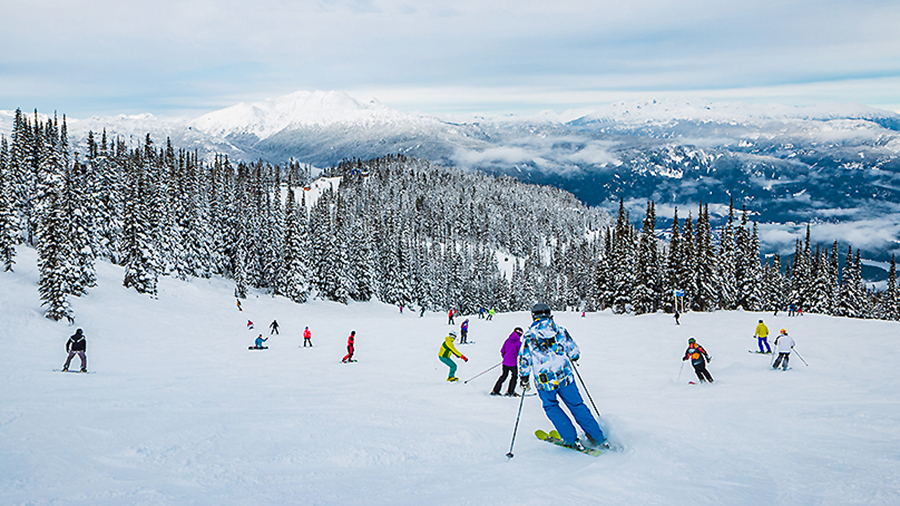Although a handful of resorts remain open, the Winter 2022/23 ski season is ending on a high note due to extraordinary snowfall across most regions, particularly in the West, according to the most recent data released by DestiMetrics.
The data from DestiMetrics, part of the Business Intelligence division of Inntopia, covers lodging properties in seven Western states and includes the preliminary findings of the National Ski Areas Association (NSAA), which reported a record 64.7 million skier/snowboarder visits to U.S. resorts this winter. And while not all daily visits included an overnight stay, the high snow levels elevated occupancy and revenues for a more robust finish than forecasted in the high inflation environment and rising interest rates when the season returned in November. However, the upcoming summer months are seeing a slowdown from the winter season and previous summers. Data collected through April 30 by Destimetrics continues to see a notable decline in on-the-books occupancy for the summer 2023 and softening lodging rates.
Destimetric’s May Market Briefing offers a single year-over-year comparison and a four-year comparison—April 2019 during the last pre-pandemic ski season and the previous pre-pandemic summer season. Comparisons to two and three years ago are skewed due to the pandemic’s impact on travel for those years, from a complete shutdown to tentative re-openings followed by surges due to pent-up demand. The Destimetric’s data also warns about how the economy is starting to rattle summer mountain travelers’ confidence and vacation planning.
Strong Finish For April Lodging
Courtesy of excellent late-season conditions, occupancy for April was up 5.3 percent in a year-over-year comparison, while the Average Daily Rate (ADR) was up a modest 2.7 percent. That growth in both categories resulted in aggregated revenues up 8.1 percent compared to last year. A comparison to April 2019 shows that occupancy was up 12.4 percent and, when coupled with ADR, which was up 53.6 percent over four years ago, brought in a 72.6 percent increase in revenues for the month.
Summer Occupancy Looks Shaky
Compared to the stellar winter, economic challenges have influenced bookings for the upcoming summer season. On-the-books occupancy from May through October is down 9.1 percent compared to last year, with decreases in all six months—a slight improvement from the 13.3 percent decline for summer reported at the end of March but only achieved with declining room rates. Summer ADR is up 2.8 percent, with increases every month except October, down 0.4 percent; this is a significant retraction in rates from March 31, when they were up 6.5 percent. The improvement in occupancy driven by softer rates indicates economic forces impacting travel at mountain destinations.
“For almost two years, lodging properties have been able to hold rates and depend on occupancy being driven by either pent-up demand or in the case of the past winter, good snow,” explained Tom Foley, senior vice president of Business Intelligence for Inntopia. “But with most of the pent-up demand met during 2022 and with snow a non-factor in summer bookings, we’re seeing traditional market forces coming into play in mountain communities and are making it very clear that travelers are a lot more rate sensitive this summer than they have been for a very long time.” Foley clarified how rates are shaping Summer 2023 in these destinations. “The softening in daily rates over the past 30 days is directly correlated to improved summer occupancy levels, and lodging properties will have to pay attention to that price sensitivity in the weeks ahead.”
Foley also noted an irony in how snow is having an impact on summer. “May is currently the softest month of summer, and that probably has something to do with all the snow remaining, which is causing some special events to be either pushed back or canceled as mud season persists a lot longer this year in many locations.”
Foley also pointed out that “the modest 2.8 percent rate increase is not enough to offset the lower occupancy, and the net effect is a 6.5 percent decrease in summer revenues in a year-over-year comparison—the first seasonal decline since immediately after re-opening in 2020.”
Compared to the same time four years ago, the last summer before the pandemic, occupancy was down 8.8 percent, but the daily rate were higher than in summer 2019 and up 40.8 percent to deliver a revenue increase of 48.4 percent.
A “Win” For Winter 2023
From a tentative start in November when occupancy was down and the economic news was challenging, in a year-over-year comparison, Winter 2022/23 had a 0.2 percent gain in occupancy with declines in four of the six months, all but January and April; however, the real victory for lodging properties were daily rates and revenues.
The ADR for the winter finished up 5.9 percent over last year and, along with the small uptick in occupancy, provided a 6.1 percent increase in revenue over last winter.
The more striking comparison was four years ago and the last full pre-pandemic season. Occupancy was down 0.4 percent, but ADR was up 43.1 percent to deliver a 43.6 percent increase in revenue from four years ago.
“Widespread and truly remarkable snow conditions this past winter went a long way to encouraging skiers to shrug off some of the worrisome economic news and indulge in some overnight stays despite high rates and setting an astonishing new record for skier visits this season,” noted Foley. “But mountain destinations cater to a more price-sensitive consumer during the summer months and with high inflation and rising interest rates persisting and discouraging big-ticket purchases such as travel, the unchecked pattern of escalating daily rates appears to be coming to an end,” he forecasted.
Econometrics
For the second consecutive month, the Dow Jones Industrial Average rose during April to close 824 points or 2.5 percent higher than in March, marking only the second time since November that the Index has managed back-to-back monthly increases while recording the highest monthly close since then. Continued positive data regarding jobs and earnings, along with a slowing inflation rate, received credit for buoying financial markets.
Once again, the Consumer Confidence Index (CCI) and the Consumer Sentiment Index (CSI) had mixed results as they flip-flopped and changed directions from last month and each other.
The CCI dipped 2.6 percent during April to 101.3 points from the 104 points posted in March, marking the fourth decline since the beginning of the winter season.
“One of the most important findings was that consumers’ expectations about inflation did not change during the month, but their intentions to make a major purchase such as a home, car, major appliance, or travel declined,” cautioned Foley. In contrast to the CCI, the CSI tabulated by The University of Michigan, moved in the opposite direction and rose a 2.4 percent to 63.5 points following a sharp decline in March.
The national unemployment rate decreased again in April from 3.5 to 3.4 percent, its lowest level since 1969, and boosted by employers adding 253,000 new jobs to payrolls. Wages also posted a 4.4 percent gain compared to last year, narrowing the gap between earnings and inflation; however, the strength of both jobs and wages had not cooled inflation and could trigger the Federal Reserve to raise interest rates despite indicators that they would pause on hikes for now.
The National Inflation Rate (the difference in the price of goods this year versus last year) edged down from five percent in March to 4.9 percent in April, which is slightly better than forecasted—the tenth consecutive decline in annual inflation and its lowest level since April 2021. But, prices were up 0.4 percent from last month as the Consumer Price Index increased during April, putting some pressure on consumers despite a lower annualized inflation rate.
Winter Wrapped But Watching And Waiting Summer Shifts
Occupancy rallied and had an 0.2 percent increase in aggregated occupancy for the winter season. But summer occupancy is down 9.1 percent from last year at this time.
ADR held steady through the winter and finished up 5.9 percent over last year, but the summer forecast as of April 30 is dimmer as rates are up 2.8 percent for the summer and lower than one month ago.
Booking pace during April for arrivals in April was up 35 percent over last year at this time, fueled by high snowfall levels, but there were also booking increases for June through September, with arrivals in the months of June and August increasing 20 percent. “Room rates are the major contributing factor to the gain in booking pace for those months as the current pace of rate increases is much slower than at any other time in the past three years,” clarified Foley.
Length-of-Stay has been down year-over-year for the past 13 months, but April was the first month since February 2022 that it extended, up 0.11 nights this April compared to being down 0.14 nights last year, a strong reversal due to the exceptional late season conditions.
Moving into the summer months, the average length of stay has dipped down 0.07 nights compared to last year and is down a very sharp .027 nights compared to Summer 2019. “The numbers don’t sound that big, but shorter stays are a major contributor to slowing demand and, put simply, for every ten nights booked this summer, there are 2.7 nights fewer than in 2019, which is a substantial decrease,” warned Foley.
“The winter season certainly finished with a bang with record-setting skier visits and revenues, but so far, summer is having trouble finding any momentum,” cautioned Foley. “Shorter stays and fewer bookings are starting to force a more flexible approach to rates, so as pretty stiff economic headwinds continue to blow, lodging properties are facing a very different reality after 24 months of easy, high-rate bookings,” he continued. “Softer daily rates will be welcome news for consumers but lower rates and soft demand combine to create revenue challenges for lodging properties, so careful rate management and added-value elements become increasingly relevant for mountain destinations as they navigate the delicate balance of attracting guests and managing the bottom line,” he concluded.
















